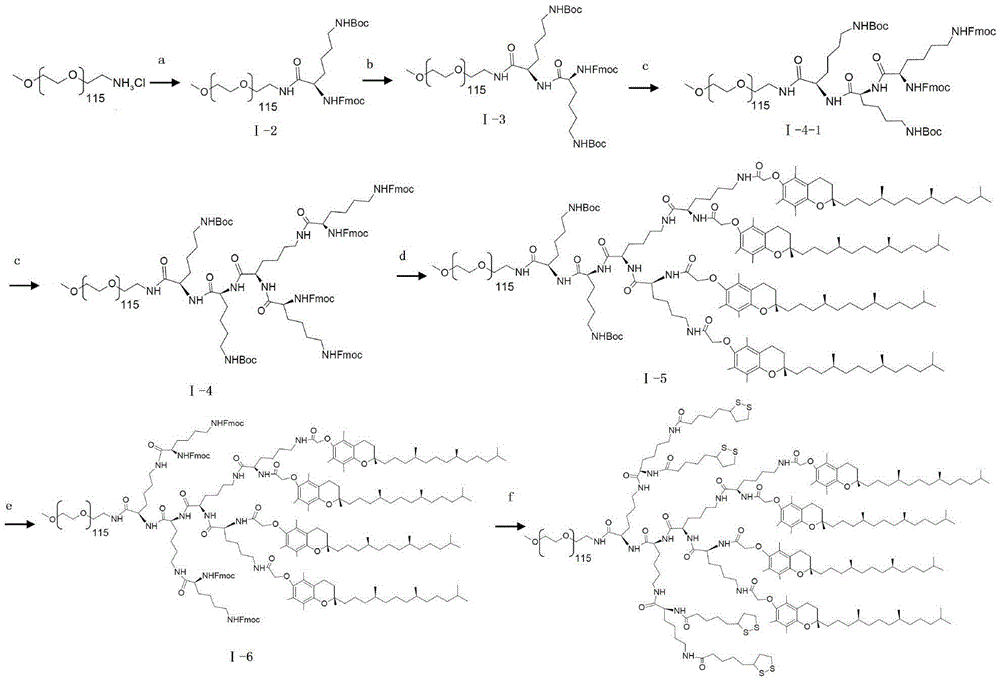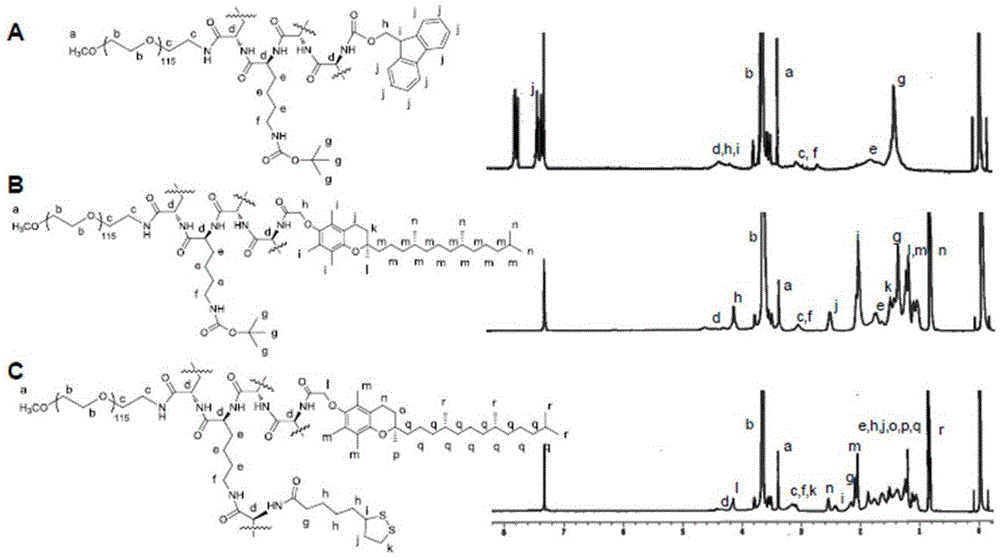Polyethylene glycol-thioctanoic acid-vitamin E copolymer and its preparation method and application
A technology of polyethylene glycol and thiooctanoic acid, which is applied in the field of nanomedicine, can solve the problems that it is difficult for nanomicelles to load hydrophobic anticancer drugs, the hydrophobicity of micellar core is weakened, and the nanomicelles cannot be loaded with drugs. The effect of increasing the dose
- Summary
- Abstract
- Description
- Claims
- Application Information
AI Technical Summary
Problems solved by technology
Method used
Image
Examples
Embodiment 1
[0043] Example 1PEG115-TA4-VE4 copolymer, prepared by the following steps (see figure 1 synthetic route shown):
[0044] (1) In a 150 mL flat-bottomed flask, add methoxy-polyethylene glycol (115)-amino-hydrochloric acid (2 g, 0.4 mmol), N-fluorenemethoxycarbonyl-N'-tert-butoxycarbonyl -L-lysine (375 mg, 0.8 mmol), N,N'-diisopropylcarbodiimide (150 μl, 0.96 mmol), hydroxybenzotriazole hydrate (164 mg, 0.96 mmol), N-ethyldiisopropylamine (350 μl, 2 mmol) and N,N-dimethylformamide (50 ml), after stirring the reaction at room temperature for 6 hours, the mixture was poured into ether (200 mL) precipitated and dried to give I-2.
[0045] (2) i) The obtained I-2 was added to a 250-mL flat-bottomed flask containing piperidine (20 mL) and N,N-dimethylformamide (80 mL), and the reaction was stirred at room temperature for 2 hours. The mixture was poured into diethyl ether (200 mL) to precipitate, and dried to obtain the defluorenated methoxycarbonyl-protected compound; ii) the obtai...
Embodiment 2
[0051] Example 2PEG115-TA4-VE4 copolymer, prepared by the following steps (see figure 1 synthetic route shown):
[0052] (1) In a 150 mL flat-bottomed flask, add methoxy-polyethylene glycol (115)-amino-hydrochloric acid (2 g, 0.4 mmol), N-fluorenemethoxycarbonyl-N'-tert-butoxycarbonyl -L-lysine (375 mg, 0.8 mmol), N,N'-diisopropylcarbodiimide (150 μl, 0.96 mmol), hydroxybenzotriazole hydrate (164 mg, 0.96 mmol), N-ethyldiisopropylamine (350 μl, 2 mmol) and N,N-dimethylformamide (50 ml), after stirring the reaction at room temperature for 5 hours, the mixture was poured into ether (200 mL) precipitated and dried to give I-2.
[0053] (2) i) The obtained I-2 was added to a 250-mL flat-bottomed flask containing piperidine (20 mL) and N,N-dimethylformamide (80 mL), and the reaction was stirred at room temperature for 1 hour. The mixture was poured into diethyl ether (200 mL) to precipitate, and dried to obtain the defluorenated methoxycarbonyl-protected compound; ii) the obtain...
Embodiment 3
[0059] Embodiment 3PEG115-TA4-VE4 copolymer, obtained by the following steps:
[0060] (1) In a 150 mL flat-bottomed flask, add methoxy-polyethylene glycol (115)-amino-hydrochloric acid (2 g, 0.4 mmol), N-fluorenemethoxycarbonyl-N'-tert-butoxycarbonyl -L-lysine (375 mg, 0.8 mmol), N,N'-diisopropylcarbodiimide (150 μl, 0.96 mmol), hydroxybenzotriazole hydrate (164 mg, 0.96 mmol), N-ethyldiisopropylamine (350 μl, 2 mmol) and N,N-dimethylformamide (50 ml), after stirring the reaction at room temperature for 7 hours, the mixture was poured into ether (200 mL) precipitated and dried to give I-2.
[0061] (2) i) The obtained I-2 was added to a 250-mL flat-bottomed flask containing piperidine (20 mL) and N,N-dimethylformamide (80 mL), and the reaction was stirred at room temperature for 3 hours. The mixture was poured into diethyl ether (200 mL) to precipitate, and dried to obtain the defluorenated methoxycarbonyl-protected compound; ii) the obtained defluorenated methoxycarbonyl-p...
PUM
| Property | Measurement | Unit |
|---|---|---|
| critical micelle concentration (mass) | aaaaa | aaaaa |
Abstract
Description
Claims
Application Information
 Login to View More
Login to View More - R&D
- Intellectual Property
- Life Sciences
- Materials
- Tech Scout
- Unparalleled Data Quality
- Higher Quality Content
- 60% Fewer Hallucinations
Browse by: Latest US Patents, China's latest patents, Technical Efficacy Thesaurus, Application Domain, Technology Topic, Popular Technical Reports.
© 2025 PatSnap. All rights reserved.Legal|Privacy policy|Modern Slavery Act Transparency Statement|Sitemap|About US| Contact US: help@patsnap.com



